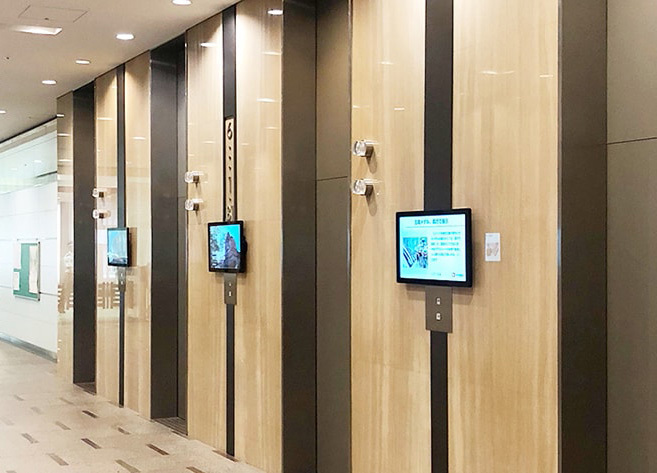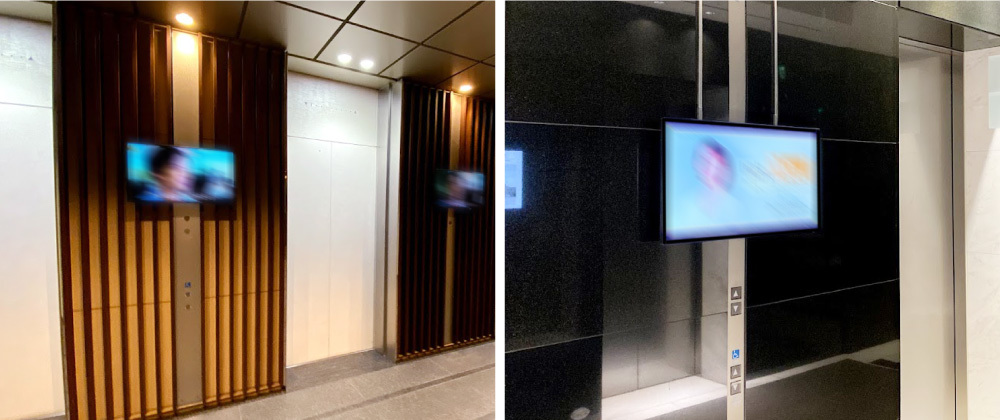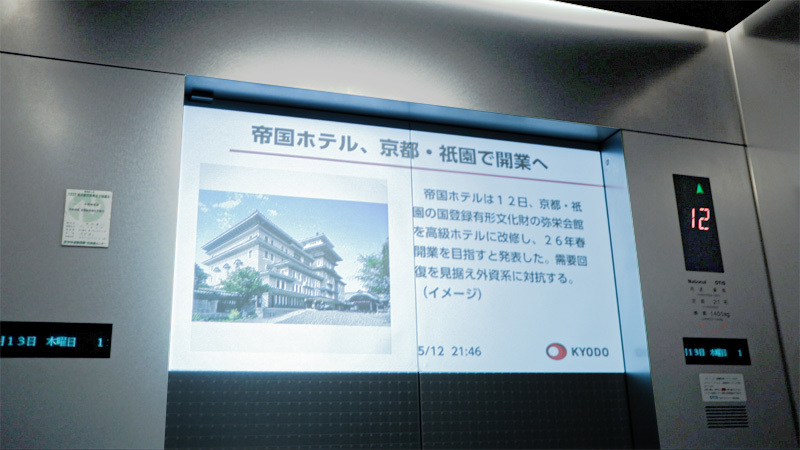Note: This website was automatically translated, so some terms or nuances may not be completely accurate.
New Trends in DOOH ~ Elevator Signage Edition

OOH (Out Of Home: outdoor and transit advertising) is expanding its market scale as digitalization advances.
Recently, various DOOH (Digital Out Of Home: advertising utilizing digital signage) formats have been gaining attention. Compared to analog OOH, DOOH offers numerous advantages: easier ad placement, higher immediacy, the ability to reach targeted audiences, and measurable advertising effectiveness.
To explore the new trends in DOOH, we spoke with Youhong Luo of Tokyo Inc., the company behind the elevator signage "Tokyo Elevator GO" and "Elevator Cinema."

Redefining Elevator Advertising: From Vehicle to Space
──What kind of DOOH do you handle?
Founded in 2017 as a Tokyo University spin-off venture, we provide a service that installs our proprietary signage and projectors in elevator lobbies and cabs of high-end S-class and A-class office buildings in Tokyo. This enables advertising delivery. Waiting for or riding in an elevator creates spare moments. We deliver informational content, building management announcements, and advertisements during these times. Our system allows easy online management of delivered content, enabling flexible distribution.
The cumulative number of units installed across the series has reached 1,000 (as of November 2021). Moving forward, we aim to expand our presence, targeting approximately 30,000 units—equivalent to 5% of Japan's roughly 670,000 elevators—primarily in office buildings and high-rise condominiums in densely populated areas like Tokyo, Osaka, and Nagoya.
──How has the response been since launching the service?
We provide the signage installation free of charge and cover all costs for the building owner's announcements, news, and other programming content. Because it's easy to implement, our elevator lobby signage "Tokyo Elevator GO" and in-elevator projection "Elevator Cinema" are often welcomed.
To ensure high installation quality, we operate with an in-house team. Thankfully, we're experiencing high demand and are currently unable to keep up with installation requests. When installing, we maintain close communication with building owners and tenants, carefully considering harmony with the building's design. Consequently, "Tokyo Elevate GO" and "Elevate Cinema," which add color to small pockets of time, contribute to enhancing the overall image of the building.
We often receive praise from clients who have installed them, such as "The elevator atmosphere improved, indirectly contributing to higher rent." Regarding "EreCinema," we frequently hear comments like, "It feels like a dash of technological spice has been sprinkled on the building."


──What types of companies are most common advertisers?
Most are B2B companies with high-value products or firms offering SaaS (Software as a Service). Office environments have strict security, so business professionals previously had almost no opportunity to encounter ads at work. However, elevator ads allow contact during office hours when people are focused on work.
Advertisers can pinpoint their ads to the elevator signage in office buildings occupied by their target companies, which is expected to improve the efficiency of subsequent sales efforts. Particularly, running product ads before high-value negotiations helps build awareness among the target company's executives and employees beforehand, making subsequent sales pitches and service implementations smoother.
We also see advertising from companies supporting office environments, such as furniture manufacturers and moving companies. Reminding them of the company name seems to lead to inquiries. Elevator signage plays a significant role not so much in the "awareness" stage of the marketing funnel, but rather in converting customers towards "contracts or purchases." Additionally, orders are sometimes placed using sales promotion budgets rather than advertising budgets.
──How has the spread of COVID-19 and the rise of remote work affected advertising sales?
With office attendance rates dropping to 40-50%, we lowered advertising slot prices. However, an unexpected finding was that many companies targeted by SaaS and DX (digital transformation) product vendors hadn't adopted remote work. This alignment with the target audience, coupled with the effect, resulted in a phenomenon where the effective cost per reach effectively halved, leading to significantly enhanced advertising effectiveness. This effect mirrored what happened when a certain HR cloud service company bought extensive train media during the state of emergency, targeting commuters with ads stating, "You came to the office just to stamp a document." Furthermore, since many decision-makers, such as executives and general affairs staff, are present in the office, it's easier to reach the target audience. As a result, we've been receiving positive feedback with all slots fully booked consistently since May.
──What are your future challenges and aspirations?
We aim to redefine the elevator from a mere vehicle into a space, while also enhancing technical aspects like utilizing all four elevator walls and improving touch controls. This will further elevate the elevator experience.
We'll also refine the content. For example, it might sound like a dream, but imagine facial recognition activating after the elevator doors close, providing personalized recommendations for each passenger. Then, they could purchase lunch inside and complete payment seamlessly. We envision a world where people can do the same things in public spaces without smartphones, hands-free.
We are also virtually transforming existing buildings into WeWork-like spaces.
Among coworking space providers, WeWork stands out for its mechanisms that foster community among tenants.
As a real estate company, if we can directly communicate with tenant companies and help form and activate communities within them, wouldn't that be a clear example of creating incentives for them to stay in the building? For an advertising agency, knowing where the service is implemented, they could announce, "Companies A and C in this building have adopted it," potentially making other companies think, "Maybe we should hear them out."
While remote work is becoming more common, there are still things that can only be created in an office. The value of an office lies in its real connections and community. We want to help build that by creating a tenant communication tool.
※WeWork: A U.S. company operating shared office and coworking spaces worldwide.
After the interview...
I found the trial-friendly business model intriguing and felt it represents a rational approach to selling B2B products. It's also unique that while B2C OOH products typically secure budgets as advertising expenses, B2B products can be allocated under different expense categories like sales or promotional costs. The pandemic brought changes to work styles, but it's also fascinating how it made it easier to reach the desired business targets.
Looking ahead, envisioning elevator ads contributing as communication tools between building owners and tenants, or even evolving into office support services that foster engagement among tenants and companies within the space—like WeWork—suggests new possibilities for office environments and workstyles.
Our article introducing new trends in DOOH also features a hair salon signage edition (read the article here ).
Was this article helpful?
Newsletter registration is here
We select and publish important news every day
For inquiries about this article
Back Numbers
Author

Kana Misawa
Dentsu Inc.
Out-of-Home Media Division
After working in creative, sports business, AI chatbot, and healthcare business development, he assumed his current position. He is involved in developing media planning tools centered on OOH and business development in the data and technology domain. Ph.D. (Interdisciplinary Information Studies)




